Duolingo Chinese
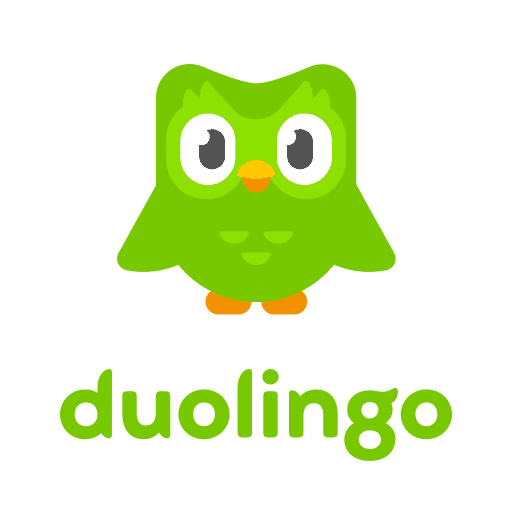
Summary
Duolingo is one of the most popular tools for learning a language and they finally released their Chinese course. Unfortunately, it’s just not very good. They fail to provide a useful course in every area except one, motivating students to continue studying. If you’re serious about learning Chinese, don’t waste your time with Duolingo.
Duolingo is beautifully designed but the lessons are terrible.
The material is covered very poorly without much for explanations.
It’s free, but your time is valuable.
I Like
- The gamification aspects and quick lessons provides enough of a push to get people to study when they might not otherwise want to.
- It’s free.
- A clean and technically well-designed product.
I Don’t Like
- A large part of the lessons are spent matching sound to pinyin and pinyin to characters. Then, all of a sudden, they expect you to know the meaning of vocabulary without ever teaching it.
- Tones and pronunciation are pretty much completely ignored.
- Recordings for more than one character end up being very choppy and unnatural sounding.
- Even if you complete the course, I doubt you’ll be able to communicate in even the most basic ways.
- Translation exercises don’t include enough variations of correct answers.
Price
It’s completely free. You can pay $9.99 per month to remove the ads and get offline access.
It’s Here!
After years of waiting, the beta version of Chinese for English speakers course was finally released on Duolingo.
It’s been a long time coming and many people had given up on it ever being released. After all, they’ve released courses for over 20 languages, even Klingon and High Valyrian (with even more in development) before tackling the most widely spoken language on the planet.
With millions of users, Duolingo is probably the most popular language learning resource around today – and it’s completely free to use.
But should you use it?
While waiting for the release of the Chinese course on Duolingo, other apps like HelloChinese, ChineseSkill, and LingoDeer came up to fill the void.
That’s not to mention all the other online Chinese courses.
So, does the Chinese for English speakers course on Duolingo live up to the hype? Should you use it to learn Chinese?
The short answer is no. Don’t waste your time with it.
But, let’s see why I feel this way.
There’s a lot to look at here. So, let’s start at the beginning…

Getting Started

Duolingo is available from their website or as an app. I’d recommend using it online as much as possible. The main reason for this is that sometimes the online lessons will include a Tips and notes section. Here you’ll find some written explanations regarding grammar rules and sentence structures. It’s badly needed as the lessons themselves don’t explain any of this. You’re expected to just learn it intuitively. This section is completely missing from the app.
When you first log in to Duolingo and select Chinese, you’ll be greeted by this screen to select your goals.
The fact that 20 minutes per day is considered insane, is well, sort of insane. For anyone studying Chinese even somewhat seriously, 20 minutes per day is nothing at all. This gives a clear glimpse into the nature and target audience for Duolingo – very casual learners.
You can then choose to start from the beginning or take a placement test.
Course Structure
The course structure is quite similar to what you’ll find other places.
There are 88 mini-units based on a specific topic, such as sports, body parts, health, and so on.
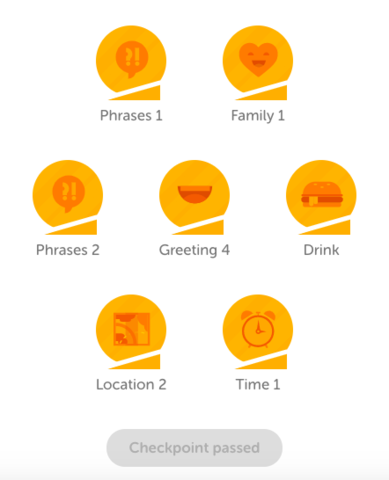
Each of these mini-units contains between 2 and 6 lessons.
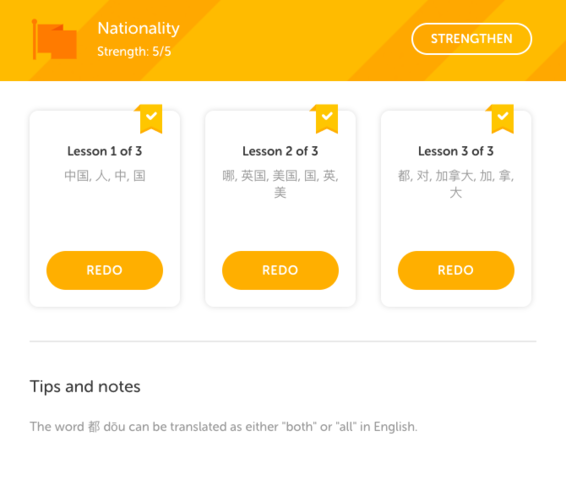
At any point, you can try to test out of these mini-units and jump ahead in the course.
The process for testing out and skipping ahead in the course is quite similar to all of the other lessons – which I’ll talk about in just a minute. The one difference is that you’re given three lives to pass the test. If you miss more than three questions, you’ll have to try again or work through the lessons in order.
Unfortunately, the translation exercises can be very unforgiving of different ways to word a sentence. This can make it quite frustrating trying to test out of the lessons.
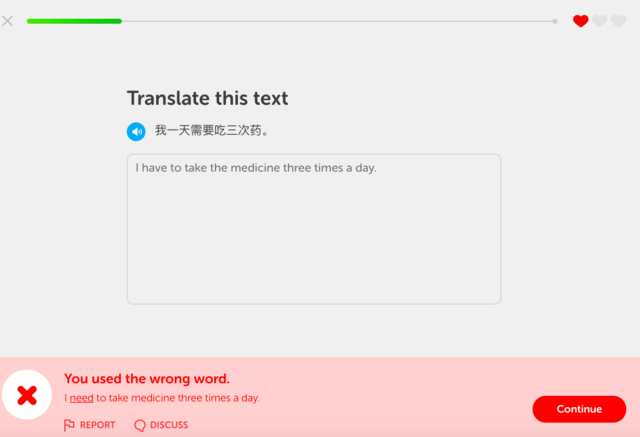
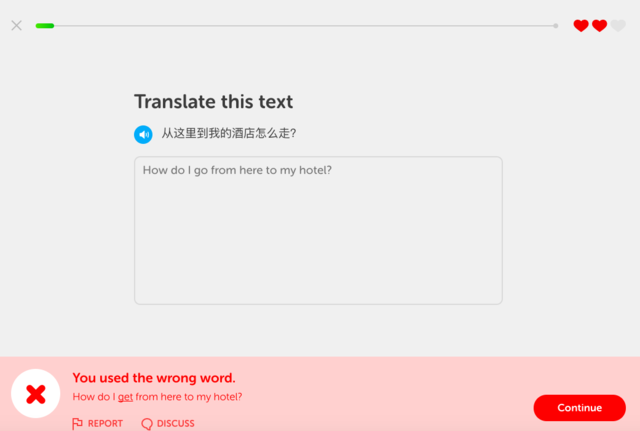
We should give Duolingo a bit of slack here though as it’s still in Beta. As more people use it and report sentence errors, the more accepting of variations it will become.
The First Lessons
One of the first things you’re likely to notice is that the lessons are incredibly easy. I know, I’ve been studying Chinese for quite awhile, so of course, the first lesson will be easy. But, hear me out…
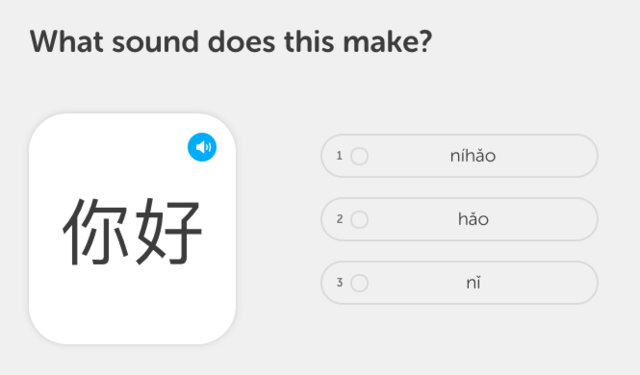
This was the first question which could be challenging if you’ve never learned any Chinese. You don’t really need to understand any Chinese to answer correctly though. The audio automatically plays. So, if you have ears, it’s pretty easy to hear the correct answer.
You answer a bunch more questions just like this.
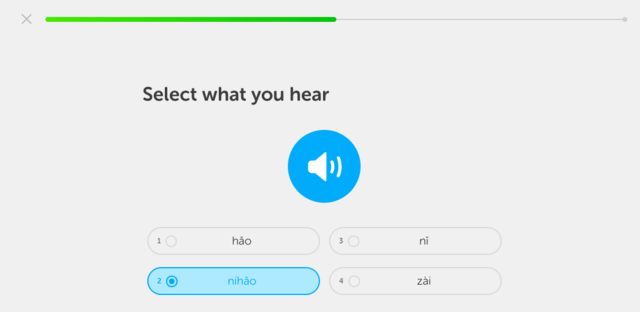
I do like that they include learning characters early in the course though. It’s not uncommon for beginners to ignore characters which can be detrimental in the long-run.
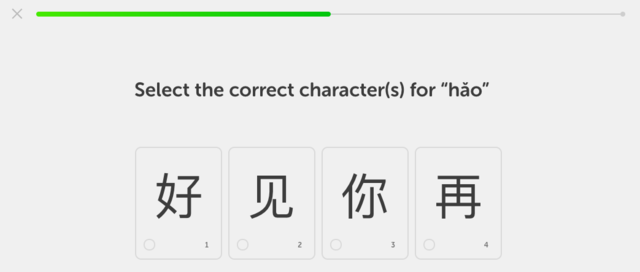

You answer probably 10 or so different questions matching the sound to the pinyin and the pinyin to the characters.
But, you still haven’t been told what 你,好,or 你好 actually means. Then, you’re greeted with this question…
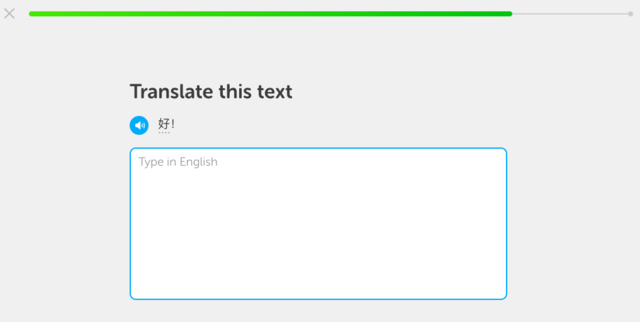
You can click on underlined words to see a translation. Still, I don’t like how many exercises you’re expected to complete before being given the meaning.
The second lesson of the first mini-unit is essentially the same, but instead, you’ll learn 再,见,and 再见. Again, the amount of time matching sounds to pinyin and pinyin to characters before telling you what 再见 means is really bizarre.
Pronunciation and Tones
Pretty much everyone will tell you that learning tones and pronunciation are critical for learning Chinese. If you use the app, you’ll never learn anything about either of these. On the website, there is a short explanation of tones, but nothing about pronunciation.
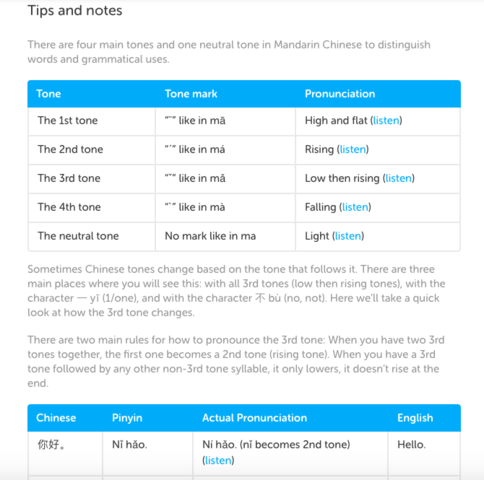
It’s not a particularly good or thorough explanation of tones, but it’s better than nothing. If you’re a beginner and insist on using Duolingo, try to use it on your computer as much as possible so at least you get this extra information.
Chinese pronunciation can be fairly challenging to learn. I expect many people taking this course will simply get in the habit of pronouncing pinyin just like they would English.
Don’t do this! People will have a hard time understanding you and it’ll take a lot of effort to fix your pronunciation problems later.
More Lessons
The lessons later in the course are essentially the same as the first ones. Let’s take a look at a later lesson, one question at a time. The topic here is telephones.


Again, these are just incredibly easy to answer. The audio automatically plays, so if you’re not deaf, it’ll be hard to answer incorrectly.
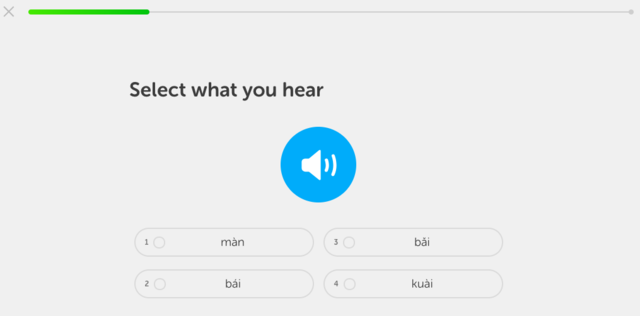
I like that they included the third tone bai here. This will make the questions more challenging and help students learn to distinguish between the sounds of different tones. Part of me thinks it was just a coincidence though.
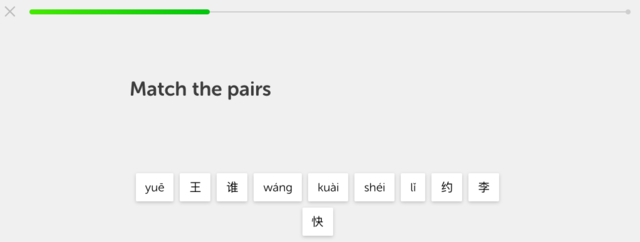


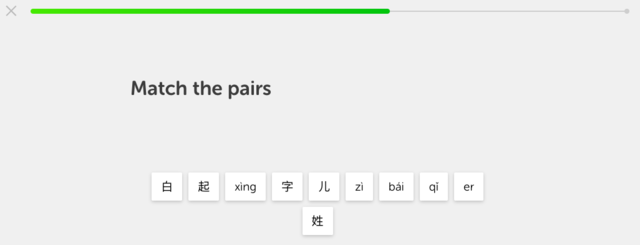
More than halfway through the lesson and we still haven’t learned anything besides pinyin and characters. What does this mean anyway?
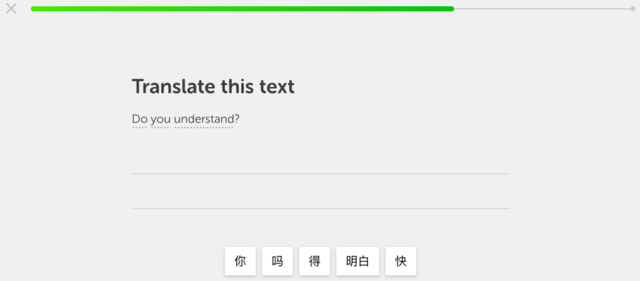
Then, all of a sudden, you’re asked to translate something. You can click on the underlined part to see a translation, but I wish they would have introduced the meaning earlier in the lesson.
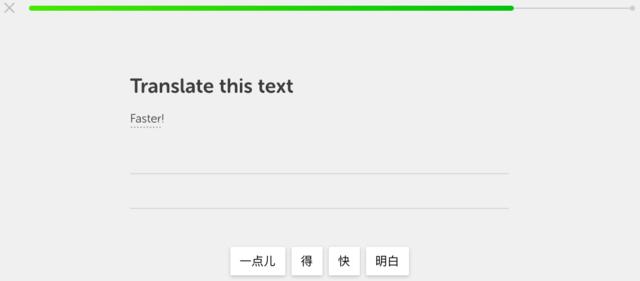
Same thing here. It feels far too late in the lesson for the meaning of 快 to be introduced. This just seems like a pointlessly inefficient way to teach vocabulary. I also dislike how little emphasis is placed on learning the meaning of characters.
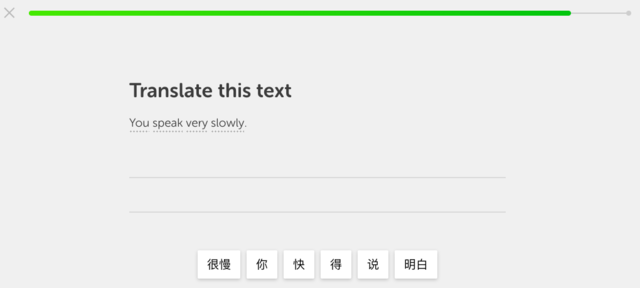
We learned 慢 in the previous lesson. So, I guess this is just basically a chance to review.
And that’s the end of the lesson. I’m not sure what just happened. The structure of this doesn’t make any sense to me.
They do at least include a little be of a grammar explanation with the website version.
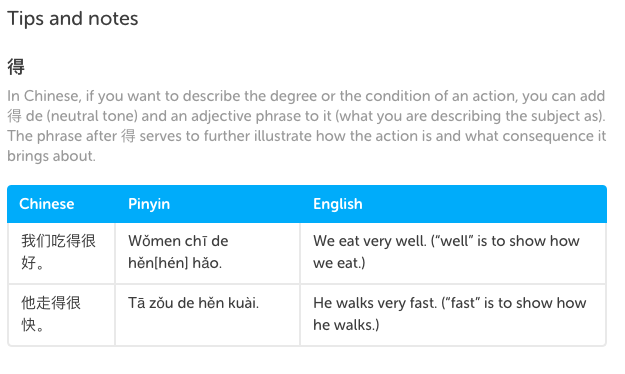
However, for someone looking to learn grammar, I’d suggest checking out the Chinese Grammar Wiki or Chinese Zero to Hero! grammar videos on youtube.
Now let’s just take a look at a few more examples from other lessons…
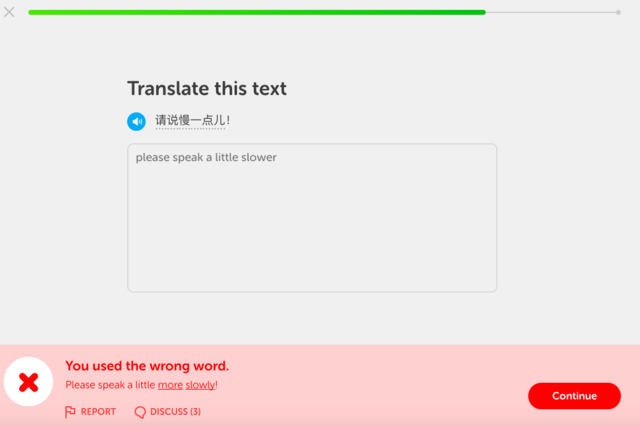
We still have the issue of not enough answers being accepted.
In some lessons, vocabulary is taught more directly. Unfortunately, there’s no need to have learned any Chinese to answer correctly…

Really? People have been waiting years for Duolingo to release a course and this is what they come up with?
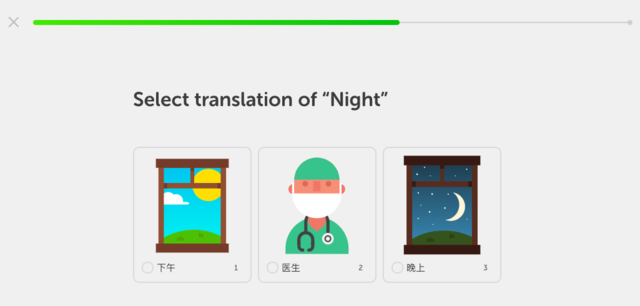
Sigh…
To me, it seems like the whole course was designed to give students the illusion of progress and keep them coming back for more. That leads to the next point…
What Duolingo Does Well

I’ve said very few positive things about Duolingo so far in this review. But, there’s one area where Duolingo really excels. That’s in motivating people to actually study Chinese. Plenty of people want to learn, but it’s easy to get caught up in the difficulties or not knowing where to start or just feeling like it’s impossible. Duolingo really makes it easy to get started and keep going.
Motivation
* Duolingo excels at motivating people to build a daily study habit. They set the bar really low. Often times this may only be five minutes per day. But when people complete these mini-goals, they’ll often find themselves studying more than they intended to.
* Using Duolingo feels a lot like playing a game. They add a lot of gaming elements to learning Chinese. For example, you can earn lingots to reward you for studying.

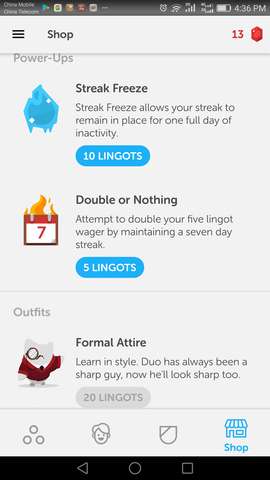
You can then use these lingots for a few different things, such as power-ups and outfits. I’m not particularly motivated by these things. I’m motivated by the fact that I live in Beijing. The better my Chinese gets, the easier and more rewarding my life becomes.
Most people don’t have such a strong motivating factor for learning Chinese. So, for them, these extras can help push them to study and provide a small reward for doing so. Again, they do a great job of pushing people to build the study habit.
* Duolingo also does a very good job of building a community of language learners. You can create or join an already existing club of people learning Chinese. You can also see leaderboards and invite friends on Facebook to join. Learning Chinese is easier when you aren’t doing it alone.
* The lessons are generally very fast and easy to pass through. This isn’t an accident. Their strength is getting casual language learners to want to study. If the lessons were too difficult or took too long to complete, people would get bored, feel demotivated, and give up. Duolingo keeps these people going.
* It’s free. Sure, you can pay $9.99 per month if you want to remove ads or download lessons from the app. But, for the vast majority of people, it’s completely free. It’s hard to complain about something that’s free, but you have to consider the value of your time as well.
What Duolingo Does Poorly
Truthfully, I think Duolingo does most things poorly and can’t see myself recommending it to anyone unless they were to completely overhaul their course.
* There’s a strange emphasis on exercises that match sounds to pinyin and pinyin to characters. The teaching of the meaning of the words and characters seems to have been more of an afterthought.
* The questions are generally far too easy and don’t necessarily require you to have learned much, or any, Chinese to answer correctly.
* The app version doesn’t include any grammar notes. You’re supposed to learn these things intuitively, but I doubt that works out well for many people. You’re not a child, learning different grammar rules can make things much easier to understand why a sentence is structured a certain way. The website version has these grammar notes, but they aren’t very complete.
* Ignoring tones and pronunciation is a great way to develop bad speaking habits and struggle to differentiate similar sounding words.
* The course doesn’t seem like it’ll really help you to communicate effectively. There’s not a lot of listening practice and no speaking exercises.
* As far as the recordings go, the pronunciation is fine when it’s only a single character. But in real life, you never hear Chinese only one character at a time. In the translation exercises, you’ll often hear a full sentence, but it sounds really choppy and unnatural. This is because each character was recorded separately, so it doesn’t flow together smoothly.
* The exercises don’t include enough variations of the answer. Many times, you’ll get an answer marked incorrect because it’s not phrased in the exact manner. This will surely improve over time, but for now, it’s pretty frustrating.
If Not Duolingo, Then What?
I think most people should avoid using Duolingo to learn Chinese. The only exception, I guess, would be for people who literally are only interested in studying for 5-10 minutes/day and find the gamification aspect enough to get them to study when they otherwise wouldn’t bother.
Even then, there are several similar apps that do most things better – especially the important stuff. HelloChinese, ChineseSkill, and LingoDeer are all significantly better than Duolingo for learning Chinese.
If you’re willing to pay a subscription and like the gamified nature of Duolingo, I’d suggest Ninchanese. It’s significantly more thorough and useful for learning Chinese.
Finally, there are several courses that, although they cost money, are worth considering if you’re willing to put in the work required to learn Chinese. ChineseFor.Us would be the best for absolute beginners, with Yoyo Chinese being another very popular option worth looking at.
Conclusion
Learning Chinese takes a lot of time. But, some resources are better designed and will help you learn the language much faster than others.
If you’re only willing to look at free resources, there are other apps that teach Chinese in a much more logical and useful way.
If you’re serious about learning Chinese, I’d suggest spending a little bit of money and gaining access to one of the many online Chinese courses.
My attitude has always been, if spending $10-$20/month on a course will save you a bunch of time, and give you a better foundation, then that’s just a good investment. Maybe you won’t get badges and achievement points, but you’ll actually learn to communicate in Chinese.
It’s a little bit disheartening that so many people are already using Duolingo to learn Chinese. They’re a huge name in language learning, and the number of people taking this course is only going to continue to grow significantly.
Unfortunately, Duolingo just isn’t very good for learning Chinese.



Thanks to Duolingo I have become able to read simple chinese texts, as well as some websites in simplified chinese. I practice about an hour a day, and also use other learning tools, such as pleco. Nevertheless, for a chinese neophyte, I am overwhelmingly grateful for Duolingo.
I want to add: the childishly easy question thing is not a bug, it’s a feature – as far as I understand it. Instead of having to read instructions and information, you get to interact and are asked a question you will probably be able to answer – without even having to study. Subconsiously/without noticing, you review the word – repetition is key to some kinds of learning – and also it’s fun because you interact and you get behaviouralistical reward and joy of achievement from that little bell sound.
Thus, this feature can arguably give important repetition learning, while keeping motivation up. Very clever indeed; almost a bit ingeneous and scary (if you think about how these techniques are used in other apps as well – creating psychological addiction).
just begun, but so far my impression of the Duolingo chinese course is good.
I completed Hello Chinese (a fantastic app!) before starting Duolingo, so thankfully I had already learned a lot of grammar and tones before using Duolingo, because I would have given up otherwise.
Duolingo is great for revising characters – *IF* you already know what they mean and just want to improve your reading.
The greatest frustration is the unspeakably poor standard of English in the course. It is so frustrating having to learn whatever mangled English sentence they require in order for you to proceed.
I’ve been doing Duolingo app for chinese for few months now and I found it to be more helpful than ChineseSkill or HelloChinese. This could be because I spent 2-3 hours a day which mostly consists of reviewing the classes. I understand that when you look at it objectively in terms of “how well it works”, Duolingo seems very poor but in terms of how it has been teaching, I found it to be very useful. I can currently read and write text messages pretty easily and started talking to people on HelloTalk. Thanks to Duolingo 🙂 I’m hoping to finish the course in another month or so and move on to fully reading chinese elementary school books.
I also tried Duolingo and I agree with what you wrote–I actually read your review before trying up to level 6 and ran in to the frustration of translation, because it’s not flexible. It also seems for the past 6 months many things were brought up inside the app feedback to the developers, but nothing has ever been done to correct it–so I just gave up on Duolingo.
Thank you for the comprehensive review and I totally agree. Courses like German or Spanish are really great and even if you just invest a couple of minutes a day you will learn a lot about these languages a day. But the Chinese course should have not been published. It makes everything wrong what made Duolingo so popular. And anyway I do not see a chance of learning Chinese characters without decomposing them just by looking at them…